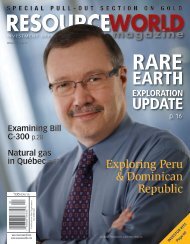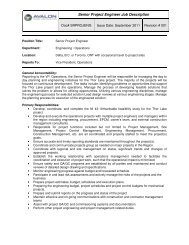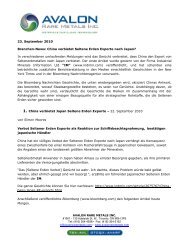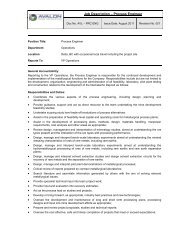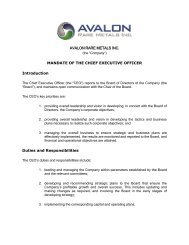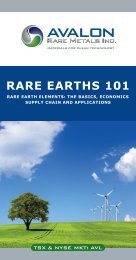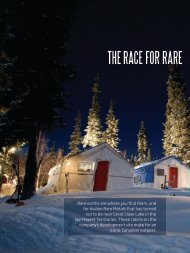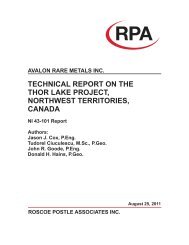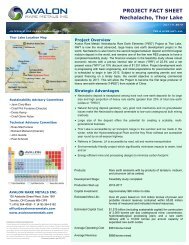- Page 1 and 2:
TECHNICAL REPORT ON THE NECHALACHO
- Page 3 and 4:
TABLE OF CONTENTS 1. SUMMARY ......
- Page 5 and 6:
QUALITY ASSURANCE / QUALITY CONTROL
- Page 7 and 8:
Warehouse..........................
- Page 9 and 10:
LIST OF TABLES Table 1-1 Summary of
- Page 11 and 12:
Table 18-9 Mine Ventilation Quantit
- Page 13 and 14:
Table 18-54 Table 18-55 Pine Point
- Page 15 and 16:
LIST OF APPENDICES APPENDIX A Block
- Page 17 and 18:
Table 1-1 Summary of Mineral Resour
- Page 19 and 20:
Royalties. The net revenue generate
- Page 21 and 22:
• The products will be shipped in
- Page 23 and 24:
• Income taxes and NWT mining roy
- Page 25 and 26:
2. INTRODUCTION This report
- Page 27 and 28:
Figure 2-2 Project Sites, Thor Lake
- Page 29 and 30:
Table 2-1 Rare Earth Element Data A
- Page 31 and 32:
LIST OF ABBREVIATIONS Units of meas
- Page 33 and 34:
4. PROPERTY DESCRIPTION AND LOCATIO
- Page 35 and 36:
The mining leases have a 21-year li
- Page 37 and 38:
5. ACCESSIBILITY, CLIMATE, LOCAL RE
- Page 39 and 40:
Fort Resolution is located on the s
- Page 41 and 42:
producing a tantalum concentrate, b
- Page 43 and 44: Figure 7-2 Detailed Deposit Geology
- Page 45 and 46: The nepheline-sodalite syenite host
- Page 47 and 48: LATE TECTONIC FAULTS Faults are pre
- Page 49 and 50: 8. DEPOSIT TYPES The mineral deposi
- Page 51 and 52: The Ore (Nechalacho) Nepheline Soda
- Page 53 and 54: from section to section - this may
- Page 55 and 56: Table 9-1 Average Percent of Ore Mi
- Page 57 and 58: The Nechalacho deposit alteration s
- Page 59 and 60: 11. DRILLING Since 1977, diamond dr
- Page 61 and 62: Foraco drill rig was added in Febru
- Page 63 and 64: CORE LOGGING AND CORE RECOVERY The
- Page 65 and 66: A high R 2 (and all regressions had
- Page 67 and 68: 12. SAMPLING METHOD AND APPROACH A
- Page 69 and 70: such as Illimausaq in Greenland, a
- Page 71 and 72: 13. SAMPLE PREPARATION, ANALYSES AN
- Page 73 and 74: limited set of elements; however, s
- Page 75 and 76: CONCLUSIONS Avalon’s conclusions
- Page 77 and 78: Tb and Dy) were routinely monitored
- Page 79 and 80: As part of the QA/QC program, Avalo
- Page 81 and 82: Table 14-4: Comparison of Niobium,
- Page 83 and 84: shows more deviation, with ALS MS81
- Page 85 and 86: 16. MINERAL PROCESSING AND METALLUR
- Page 87 and 88: In a typical test, for example CCr-
- Page 89 and 90: 17. MINERAL RESOURCE AND MINERAL RE
- Page 91 and 92: 9. TREO equivalent is estimated by
- Page 93: Table 17-4 Sample Information Avalo
- Page 97 and 98: Assay Statistics for Upper Zone* *
- Page 99 and 100: CUT-OFF GRADE A previous public res
- Page 101 and 102: underneath for SG measurement purpo
- Page 103 and 104: Figure 17-4 Density Measurements AL
- Page 105 and 106: was equal to 60 m by 60 m by 30 m a
- Page 107 and 108: Table 17-12 Detailed Resource Break
- Page 109 and 110: Table 17-13 Indicated Mineral Resou
- Page 111 and 112: Figure 17-7 Outline of Area of Indi
- Page 113 and 114: The recoveries estimated for the fl
- Page 115 and 116: grades were based upon the grades w
- Page 117 and 118: Figure 18-1 Thor Lake Site Layout T
- Page 119 and 120: Scott Wilson RPA recommends the use
- Page 121 and 122: During discussions with the mine de
- Page 123 and 124: Figure 18-4 Mine Layout Some of the
- Page 125 and 126: Figure 18-5 Mine Development Schema
- Page 127 and 128: Table 18-2 Development Tonnage Brea
- Page 129 and 130: Until the crusher is in place and t
- Page 131 and 132: Lateral Development The access decl
- Page 133 and 134: Equipment will be selected based up
- Page 135 and 136: Table 18-6 Estimated Electrical Loa
- Page 137 and 138: VENTILATION The mine ventilation is
- Page 139 and 140: for closing unused areas and for ch
- Page 141 and 142: Mine Fan Horse Power Using the same
- Page 143 and 144: Paste Fill System A paste fill syst
- Page 145 and 146:
Communications Mine communications
- Page 147 and 148:
completion of the 30 m to 50 m long
- Page 149 and 150:
HEALTH AND SAFETY All crew will be
- Page 151 and 152:
The crushing plant is designed for
- Page 153 and 154:
Table 18-12 (Cont’d) Principal Pr
- Page 155 and 156:
Figure 18-9 Hydrometallurgical Plan
- Page 157 and 158:
The Pine Point hydrometallurgical f
- Page 159 and 160:
Decant pipeworks have been included
- Page 161 and 162:
• Development of pre-feasibility
- Page 163 and 164:
Design Basis The pre-feasibility le
- Page 165 and 166:
non-woven geotextile) to prevent da
- Page 167 and 168:
divert surface drainage away from r
- Page 169 and 170:
A high pressure (200 psi) compresse
- Page 171 and 172:
Fuel deliveries are assumed to be s
- Page 173 and 174:
Mill Supplies The key mill supplies
- Page 175 and 176:
Table 18-15 Surface Equipment Fleet
- Page 177 and 178:
Figure 18-10 Thor Lake Temporary Ba
- Page 179 and 180:
• Together with the unloading log
- Page 181 and 182:
it will be necessary to upgrade the
- Page 183 and 184:
Table 18-16 Hydrometallurgical Plan
- Page 185 and 186:
Table 18-17 Surface Mobile Equipmen
- Page 187 and 188:
Rare Earth FOB China* FOB China** P
- Page 189 and 190:
• loparite and eudialyte in alkal
- Page 191 and 192:
Table 18-18 Rare Earth supply - 200
- Page 193 and 194:
Table 18-20 Rare Earth Demand by Ap
- Page 195 and 196:
Table 18-22 Proposed New REO Projec
- Page 197 and 198:
in China. On this basis, Avalon is
- Page 199 and 200:
Determine Prices for Avalon’s Pro
- Page 201 and 202:
The balance of niobium supply is co
- Page 203 and 204:
epresenting about 18% of total zirc
- Page 205 and 206:
Table 18-25 Historic Chinese Export
- Page 207 and 208:
Figure 18-16 Tantalum Markets - 200
- Page 209 and 210:
the price for tantalum chemicals in
- Page 211 and 212:
Surface Hydrology The Thor Lake dra
- Page 213 and 214:
seven) have occurred more frequentl
- Page 215 and 216:
elative to uranium, the overall eff
- Page 217 and 218:
interviews conducted for the nearby
- Page 219 and 220:
Wildlife Early science-based wildli
- Page 221 and 222:
Other environmental permits/approva
- Page 223 and 224:
TAXES The NWT diesel tax has been i
- Page 225 and 226:
Table 18-31 Mine Capital Cost Estim
- Page 227 and 228:
Table 18-33 Surface Infrastructure
- Page 229 and 230:
Table 18-36 Indirect Cost Estimate
- Page 231 and 232:
Table 18-37 Contingency Allowance A
- Page 233 and 234:
Operating Cost Exclusions The opera
- Page 235 and 236:
Table 18-40 Underground Mine Cost S
- Page 237 and 238:
Table 18-41 Mine Cost Details Avalo
- Page 239 and 240:
Thor Lake Surface The Thor Lake sur
- Page 241 and 242:
Table 18-45 Sales and Marketing Cos
- Page 243 and 244:
Table 18-47 Rail Car Load Limits Av
- Page 245 and 246:
there will be no overhauls in the i
- Page 247 and 248:
Other supplies and freight will be
- Page 249 and 250:
Table 18-55 Hydrometallurgical Plan
- Page 251 and 252:
Table 18-56 Cash Flow Summary Techn
- Page 253 and 254:
The sensitivity of the base case 8%
- Page 255 and 256:
19. INTERPRETATION AND CONCLUSIONS
- Page 257 and 258:
• The Mineral Reserves, which hav
- Page 259 and 260:
20. RECOMMENDATIONS The authors of
- Page 261 and 262:
21. REFERENCES BCC Research (2009):
- Page 263 and 264:
MDN Inc (2010): News Release Melvil
- Page 265 and 266:
Wardrop Engineering Inc. (2009): Th
- Page 267 and 268:
23. CERTIFICATES OF QUALIFIED PERSO
- Page 269 and 270:
CERTIFICATE OF QUALIFIED PERSON I,
- Page 271 and 272:
CERTIFICATE OF QUALIFIED PERSON I,
- Page 273 and 274:
Section 416000 Section 416100 Secti
- Page 275 and 276:
Section 416600 Section 416700 Secti
- Page 277 and 278:
Section 417200 Section 417300 Secti
- Page 279 and 280:
Technical Report 43-101 - March 13,
- Page 281 and 282:
Technical Report 43-101 - March 13,
- Page 283 and 284:
Technical Report 43-101 - March 13,
- Page 285 and 286:
Technical Report 43-101 - March 13,
- Page 287 and 288:
Technical Report 43-101 - March 13,
- Page 289:
Technical Report 43-101 - March 13,





